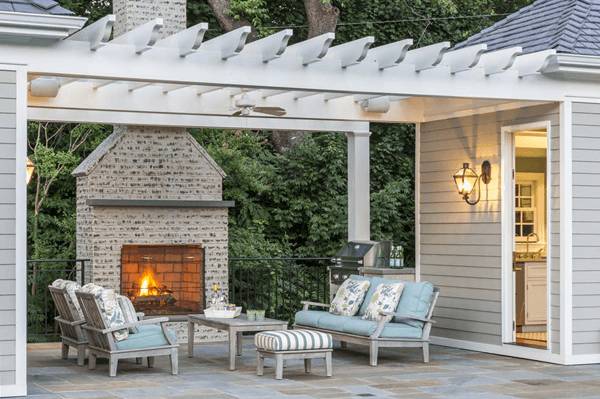The Ultimate Guide to Building Your Dream Patio Cover
Are you interested in how to build a patio cover? It is essential for any outdoor living space to have a patio cover. Patio covers provide numerous benefits and enhance the overall appearance appeal of the patio area, serving as a wonderful place to relax and enjoy quality time with your family and friends.
One of the reasons why patio covers are important is they provide protection against various weather conditions and elements. Patio covers provide the dual benefit of allowing you to enjoy your patio space while simultaneously shielding it from external factors such as direct sunlight.
This article will give you an in-depth guide on how to build a patio cover, including the factors you need to take into account.
What is a Patio Cover?
A patio cover is a structure designed to provide shelter and shade to an outdoor patio or deck area. It is typically attached to the exterior of a house or freestanding, and its primary purpose is to protect the patio from direct sunlight, rain, and other weather elements. Patio covers are constructed using various materials such as wood, aluminum, or vinyl, and they can come in a variety of styles and designs to complement the aesthetics of the outdoor space.
Additionally, patio covers also provide privacy, allowing you to enjoy a more intimate and private setting. This creates a space where you can relax and entertain, feeling protected and secluded from the external disturbances.
Designing Your Perfect Patio Cover: Factors to Consider
Here are the following factors to consider when building a patio cover.
Determining the purpose of your patio cover
One of the first things you need to consider is the reason for building a patio cover and its purpose. That is why you need to assess how you plan to use the space in order to determine the most suitable patio cover design for your needs.
Some of the common purposes may include creating a shaded area where you can relax, having an extra space where you can dine or entertain guests, or finding means to enhance your outdoor visual appeal and experience.
Understanding your budget constraints
The next thing you need to assess is your budget plan and limits. It is essential to be mindful of your budget to avoid overspending. Budget planning is crucial, especially when choosing different materials, determining the size and dimensions of the patio cover, and considering the specific requirements of the area where the patio is located.
Types of Patio Covers
Here are the different types of patio covers that serve different purposes, each with its own unique characteristics and advantages.
Solid Roof Covers
These types of patio covers are in the form of a solid, permanent roof, providing complete protection from the elements. They are typically constructed using durable materials such as wood, aluminum, or insulated panels.
Pergolas
These types of patio covers are open-air structures with vertical posts and crossbeam frameworks, offering partial shade and emphasizing a more open and aesthetically pleasing appearance. They are typically constructed using materials such as wood or vinyl.
Shade Sails
These patio covers are visually striking and feature a canopy anchored to supporting poles or structures. Shade sail covers provide partial shade and come in various shapes and sizes, allowing for creative and customizable installations.
Retractable Awnings
These patio covers are versatile and designed to be extendable and retractable. They are made of fabric supported by a frame, making them flexible and adjustable to accommodate different weather conditions.
Gazebos
These are freestanding structures that are often placed in gardens or large outdoor spaces. Gazebos are made of wood, metal, or vinyl and usually take the design of a solid roof with open sides.
Patio Cover Design and Considerations
After exploring the various types of patio covers, it is important to understand how to select the appropriate design elements for your patio cover. Here are some of the
Size and Shape
It is crucial to consider the size and shape of the patio cover that best suits your outdoor space and meets your needs. Consider factors such as available backyard and patio space, intended use, and cover-to-space proportions.
In addition, Consider patio cover design for seamless integration with your outdoor space. This includes considering the materials, colors, patterns, and architectural style of the patio cover to ensure a cohesive and aesthetically pleasing look for your outdoor space.
Planning and Obtaining Permits
To initiate the construction of your patio cover, it is essential to consult with the local planning office or department to obtain specific information regarding the applicable regulations and codes required for the project.
These regulations include zoning laws, construction codes, and application guidelines, ensuring compliance with legal and safety standards in construction
Construction Process
Begin DIY patio project by site preparation. This includes clearing the land, removing any existing debris, and ensuring the ground is level.
After site prep, install foundation and support for a stable construction base. This involves setting up columns or load-bearing elements according to your plans.
After completing the support structure, you can commence the roof installation. This step involves installing the roofing materials to provide the desired coverage and protection for your patio.
For beginners, seek specialist guidance for a successful project.
In Summary
In summary, building a patio cover offers several benefits. It provides a shield from the elements, allowing you to enjoy your scenic view while staying protected.
Moreover, a patio cover enhances the aesthetics and appearance of the space, becoming an integral part of your property’s decoration.
If you’re ready to construct your dream patio cover, consider working with one of the leading patio builders at Progressive Builders.LA, please don’t hesitate to contact us here for more details.





